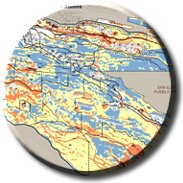- Los Alamos County Land Transfer Feasibility Study.
Los Alamos National Laboratory and the U.S. Department of Energy
Resource Dimensions led the team that analyzed and evaluated Los Alamos County's request that the DOE transfer approximately 3,000 acres of land for economic development purposes. The project team identified multiple operational, environmental and developmental constraints and with subject matter experts weighted them as to importance and rated them as to severity. GIS was used to analyze the data, quantify constraints and to display results to DOE management. This resulted in a DOE request to complete a similar analysis for the entire 45 square mile site.
- Nation-wide Uniform Conservation Enabling Legislation Assessment.
Resource Dimensions Principal Dr. Julie Ann Gustanski and several senior partners including Drs. Tom Daniels and John Wright conducted a nationwide review and comparative analysis of conservation easement enabling legislation. The assessment and recommendations on proposed conservation easement law amendments led to work with colleagues from across the nation on an in-depth assessment of conservation laws and complementary case studies reflecting state-of-the-art applications of easements in practice, and the publication of the first comprehensive evaluation of conservation easements across the country, Protecting the Land: Conservation Easements Past, Present, and Future (Island Press).
- Los Alamos National Laboratory Wildland Fire Management Plan.
Los Alamos National Laboratory and the U.S. Department of Energy
In May of 2000, the Cerro Grande Fire burned approximately 45,000 acres of land adjacent to and within the 45 square mile Los Alamos National Laboratory (LANL) site. To assure the protection of lives, facilities and the environment from future wildfires, Resource Dimensions led the team that developed LANL's Wildland Fire Management Plan using a risk-based approach. Project goals centered on identifying specific resource target locations to reduce high wildfire risk. Using GIS, the site was assessed for fuel hazards, risk of occurrence, essential infrastructure, other values at risk, and preparedness/firefighting capability. The plan identifies approximately 3,800 key acres which require treatment in the near term to reduce risk to an acceptable level. The plan was subsequently approved by the Department of Energy, which then enabled use of prescribed fire as a cost effective forest management tool.
- Policy Analysis and Guidance on Probable Benefits & Costs and Least Burdensome Analysis – Chapter 173-565 WAC Rule-making.
Washington State Department of Ecology and Center for Environmental Law and Policy
Resource Dimensions provided a range of analyses and evaluations relative to the development of net maximum-benefit rulemaking and the cost-benefit analysis process to be applied in relation to future water rights allocations from the Columbia River. The basic idea of cost benefit analysis with regard to its use here was to provide a method for formally determining the allocation of water rights in a way which will produce the greatest net benefit. Various analyses centered on evaluation of classic positions on the issue of optimality of net benefits: the Pareto-optimality and the Kaldor-criterion.
- Economic Impacts of Proposed Revised Critical Habitat Rule – Canada Lynx.
Washington Snowmobile Association
Resource Dimensions assessed the extent of likely post-designation economic impacts to the snowmobiling industry and other small businesses in rural Washington State due to critical habitat designation for the Canada lynx, based on the anticipated impacts to the level of snowmobiling activity. The North Cascades has become a haven for a diversity of winter recreational opportunities as backcountry skiing, snowmobiling, and snowshoeing for residents and visitors. The areas accommodations include a diversity of businesses that capitalize on their location in the foothills to attract visitors who take advantage of the varied year-round recreational activities. As a result the regional economy and quality of life are significantly impacted by recreation-based recreation. The Team used an input-output model to estimate impacts to the regional economy at various discount rates.
|

